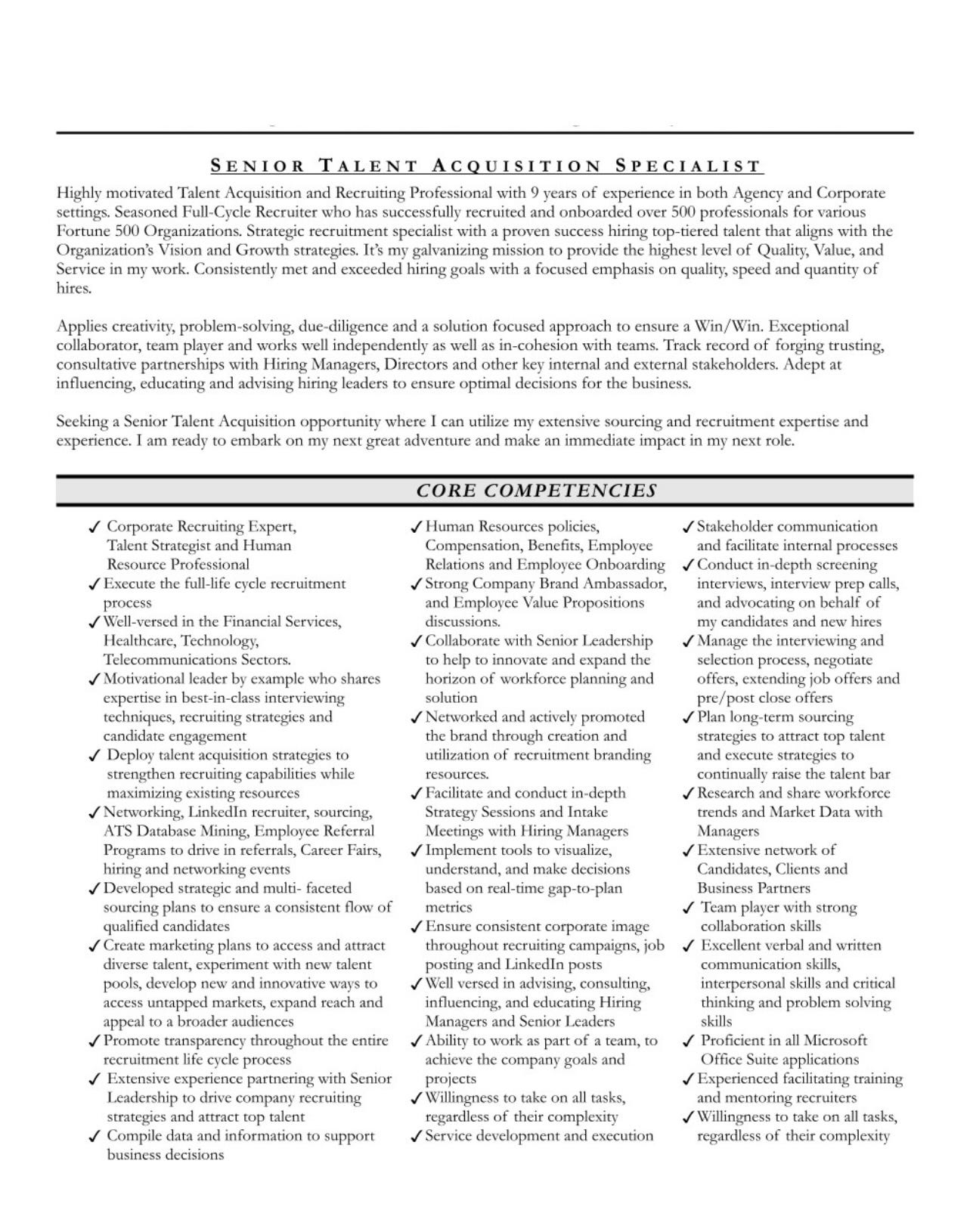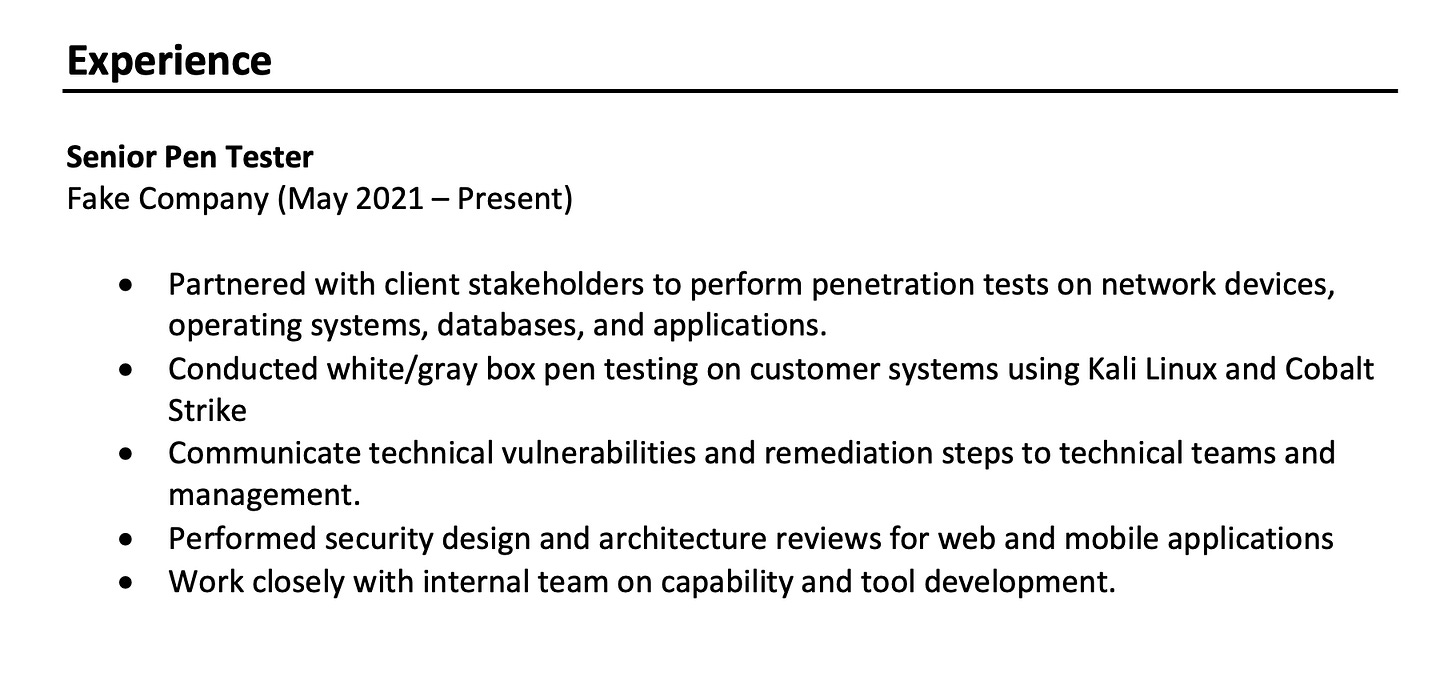How to Write a Cybersecurity Resume
A step-by-step guide to make yours stand out.
I’ve reviewed thousands of resumes in my career. Here’s the truth.
Most of them are bad.
Some of them are good.
Very few are great.
Resumes are just one part of the equation but they’re still important in today’s market. Depending on the role, you may be 1 of 200 applicants. Submitting a good resume can drastically increase your chances of getting noticed and invited to interview.
Some quick thoughts before we get started.
The things I’ll teach you today are general principles. Resumes are personal documents and should be unique to you and your target role. For example, a CISO resume will look much different than an entry level Analyst.
Every Recruiter, hiring manager, and mentor has their opinion. While I’m confident what I teach works, someone else might tell you something different.
Length really doesn’t matter. Don’t listen to anyone that says “your resume has to be 1-2 pages!” As long as it’s formatted in the right way and represents your experience, length is not a huge factor. Just use common sense. If your resume is 10 pages, that might be a bit much.
What is the purpose of a resume?
A resume has two purposes:
To help your reader find key information about you as fast as possible.
People don’t read your resume line by line; they scan it for just a few seconds. So make it read for speed.
To show your value.
Hiring managers want someone who can do the job and do it well. Your resume is the proof of that.
Here’s what not do do.
No picture. Pictures belong on social media. Putting one on your resume is a distraction and opens you up to bias/discrimination. Don’t do it. The one exception is if pictures are the norm for your culture/country. (This image was pulled from google btw).
No lengthy text (paragraphs). Recruiters and Hiring Managers may review dozens of resumes for one role. They don’t spend time reading every piece of information. Keep that in mind and go easy on the long text.
Don’t do this …
Overbearing designs, color schemes, or formatting. The focus should be on the content. For the most part, no one cares if it’s pretty. I’m not saying you can’t add some personality and color to your resume. I’m saying you shouldn’t overdo it. The exception here is if the role you apply to is in the marketing/creative space. (this example was pulled from Google btw).
Be prudent with how much personal information you share (e.g., how many kids you have, what your hobbies are, etc.). You would be shocked what people put on there. These things can be a distraction and open you up to bias/discrimination so proceed with caution.
Don’t list everything about yourself. The purpose of a resume is not to share everything about yourself so don’t go overboard. Your audience only cares about the relevant stuff.
Don’t list soft skills. Listing things like “leadership” or “diligent” or “team player” doesn’t mean much on paper. You should demonstrate these abilities with examples in the bullets points of each role you’ve had. Recruiters and hiring managers aren’t screening for these during the resume review process. You’ll have the chance to showcase soft skills during the interview.
Customize it.
Resume editing can become a never ending rabbit hole that sucks you in. Don’t worry about making it perfect. However, once you’ve got a solid format to work off of, try customizing it for the role you applied to. For example, instead of listing EVERY tool you’ve used, list the tools in the job posting that you have experience with. Or you might focus on your client-facing experience if that’s something the company wants.
How to structure your resume.
To help visualize this, I’m going to provide screenshots using a fake resume for “Senior Pen Tester”.
The English reading pattern goes left to right, top to bottom. Make sure your resume flows with this to make reviewing easy on your reader. Don’t make them jump around the page to find information.
Here’s how I would do it from top to bottom:
PERSONAL INFO
SUMMARY
EDUCATION
SKILLS & ACHIEVEMENTS (includes speaking engagements, research contributions, side projects, etc.)
WORK HISTORY
PERSONAL INFO.
Recruiters and hiring managers are looking for key words. Some of the most important key words are job titles. To make that as obvious as possible, I would put the title (if you have experience) or the discipline (if you’re a newb) next to your name.
Example:
“Senior Pen Tester” OR “Penetration Testing”
SUMMARY.
This is a high-level statement that explains how much experience you bring and what your areas of expertise are. Based on the role, Recruiters do screen for years of experience so giving them that number up front helps you. If you’re entry-level, you can put something like, “recent graduate of [school or bootcamp] with familiarity and experience with [xyz].”
EDUCATION.
If the job you applied to requires a degree or specific certifications, that’s the very first thing Recruiters will look for when screening. They’ll automatically knock anyone out that doesn’t meet the minimum standard. I like to list education near the top to make it clear what my qual’s are. It doesn’t matter how you design this section, just make it clear and simple.
SKILLS & ACHIEVEMENTS .
If the job postings lists certain skills or technology , make sure to list those that you have experience with. These hot buttons will stand out.
WORK HISTORY.
I recommend putting your job title(s) in bold text because that is more important than where you worked. Recruiters and hiring managers aren’t scanning for specific company names, they’re scanning for job titles (btw, if your company gives you a weird title that doesn’t match the market, put the market title on there). Be careful not to go overboard here and write too much. I recommend 5-7 bullet points per role. Bullet points should share what your day-to-day is, the scope of your role, and specific accomplishments. It’s good to share what you do. It’s better to share how well you do it (use data and statistics where possible).
HERE’S THE ONE PAGE EXAMPLE - Notice how easy it is to scan for key information and see my experience. Within seconds you can see what type of professional I am, how much experience I have (and what type of experience), my education, my certs, and the start of my work history.
Closing Thoughts
Resumes are not a magic bullet. You could perfect the format but if you don’t have the required experience or if someone better applies, you’ll get rejected. However, improving yours gives you a significant advantage when trying to stand out.











Awesome guide! Thanks Josh :)
Thank you Josh for the amazing and concise guide!!
However, considering entry level jobs/internships, is there any requirement of using any numbers/metrics to justify our impact on the tasks that we performed? If so how many would be sufficient?